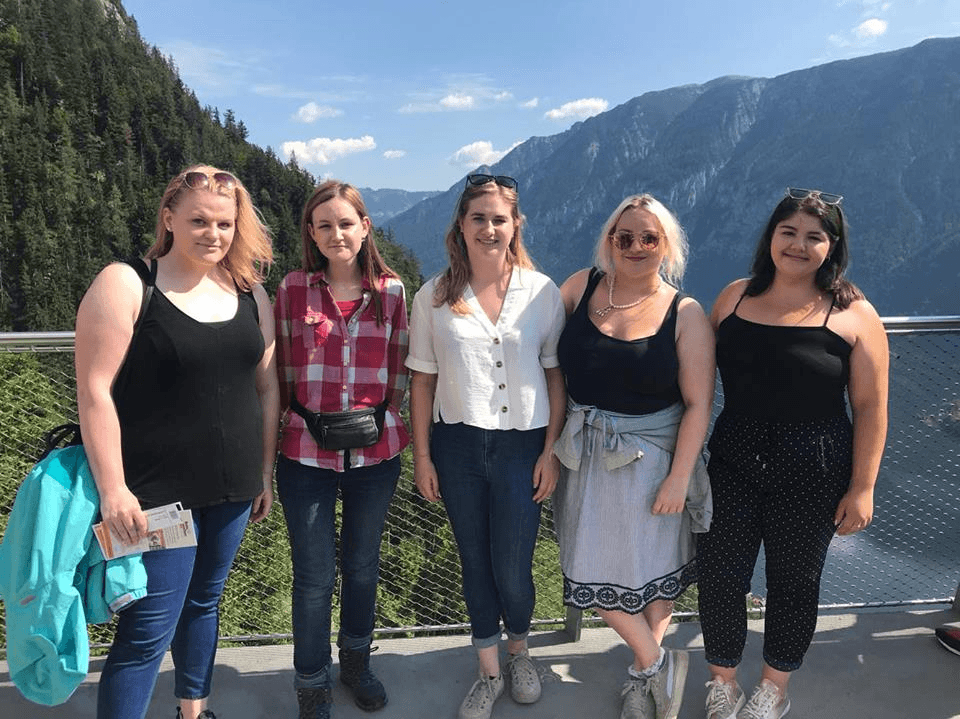By Michelle Penn
Level 3 History Undergraduate

When I received an email about an opportunity to take part in a mostly expenses-paid, month long, archaeological dig in the Austrian Alps, the thought of actually digging barely crossed my mind. However, the trip that I and my fellow students embarked on in Austria proved to be an extraordinary and memorable experience.
After flying in to Vienna on 1 July, we were driven two-and-a-half hours to the location of the dig, Schloss Hanfelden. The castle is situated in a small village in Styria called Unterzeiring, which dates mostly from the 15th century. Schloss Hanfelden was not built as a defensive keep but instead as a place to collect tolls. This location was chosen as Unterzeiring was ideally placed between Italy and contemporary Bavaria, making it a key point for travelers passing through. During the tour we learned that the castle is renowned as a site visited by the Holy Roman Emperor, Maximilian I, in the early 1500s. This is known due to the painted inscription detailing the visit, though as it was written some years later it is not a wholly reliable source.

The dig has been running since 2016 and is led by the Department of Prehistory and Historical Archaeology at the University of Vienna, which had previously started work in two rooms of an outhouse and opened some trenches outside. The aim of this year’s excavation was to tackle some unanswered questions from the past two years and uncover new features and finds in other areas. The digging started that first afternoon as we began stripping the grass of the trenches, as well as receiving some information about how the dig would work. On this excavation in particular, as in other areas of Europe, archaeologists are taught to dig strati-graphically, identifying the date of the soil layers by the features left behind. To begin with, this process was difficult for us to get to grips with, as it relied on a deeper understanding regarding what we were looking for, including subtle changes in the soil’s texture, colour and even smell. Our day-to-day roles also included ensuring the soil we removed was properly sieved and placing the finds in bags with the correct labels for cataloguing. Every day, each archaeological process got a little easier as we got more accustomed to the rhythm of the work and the routines involved.

Over the course of the following few weeks we opened three trenches outside of the castle’s keep but still within its outer walls. One of these trenches was dug in the hope of uncovering the remains of a road that would have been used by the aforementioned travelers. In the end, although stones were found that could have formed part of the early modern structure, the results, to us at least, were inconclusive and might be further explored next year. Another trench was opened to answer a key question from the previous dig regarding what kind of drainage system was in place. Due to the steep shape of the roof on the keep, the water would have originally pooled in the center courtyard. The trench revealed the solid remains of a well towards the front wall of the castle, however, due to the time limits of the excavation we were unable to dig deeper than roughly a decade.

Outside the excavation, we had three weekends to explore the local area and other parts of Austria. One weekend that was particularly exciting was our visit to Gmunden and Hallstatt. Hallstatt is a popular tourist destination, being the location of a famous salt mine which we explored on a very sunny but very busy Saturday. The Professor in charge of the dig, Frau Professor Claudia Theune-Vogt, arranged the trip as she was visiting Hallstatt to be interviewed for a television program regarding her work with Memory of Mankind. Memory of Mankind is a project run by both historians and artists, with its aim being to archive our knowledge of the world as it stands today in a physical form, engraved on tiles of ceramic that are stored and preserved within the salt mine itself. It is described as “one of the most ambitious time capsules of humankind” and is arguably one of the most unique and farsighted projects of the twenty first century. We were fortunate to be given a token by Martin Kunze, founder of MOM, which acts as a sort of treasure map, marking the location of the archive. Every 50 years members will meet to discuss whether the project is in need of updating or, in the future, if they still know why they are meeting or where the archive is.

Back at the dig, we worked alongside archaeology students from the University of Vienna. Though language was sometimes a barrier and twenty of us sharing limited bathrooms for a month was not always enjoyable, getting to know them and learn about being a student in Austria was a fantastic experience and one of the highlights from the trip.

The excavation as a whole was an unforgettable experience. It was hard work yet the positives of our stay outweighed any negatives. We all pushed ourselves out of our comfort zones and I personally felt as though I learned a lot of life skills. As such, I’m very grateful for the whole experience.

Further information:
For more information on the Memory of Mankind project visit https://www.memory-of-mankind.com/
Photos:
Property of Samantha Ann Rose Brinded
Edited by Samantha Ann Rose Brinded
